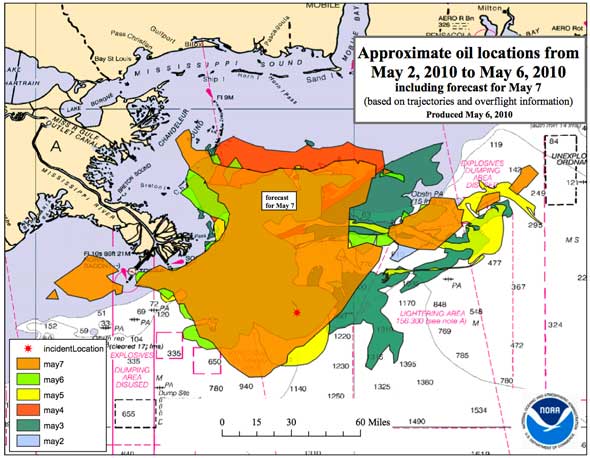
A sea turtle in the gulf surfaced Wednesday to feed, swimming through patches of oxidizing oil mingling with chemical dispersants used by BP to break up oil.
– Poisonous chemicals used to fight Gulf oil slick (MSNBC):
As they struggle to plug a leak from a ruptured oil well in the Gulf of Mexico, BP and federal officials are also engaging in one of the largest and most aggressive experiments with chemical dispersants in the history of the country, and perhaps the world.
With oil continuing to gush from the deep well, they have sprayed 160,000 gallons of chemical dispersant on the water’s surface and pumped an additional 6,000 gallons directly onto the leak, a mile beneath the surface.
– New NOAA Projections Show Slick Curling Ominously Around The Louisiana Coast (Business Insider):
– Gulf of Mexico oil spill: giant dome sent to capture leaking crude (Telegraph):
BP has dispatched a giant concrete “dome” on a high-stakes mission to contain the Gulf of Mexico oil spill, knowingt that failure would leave crude spewing into the sea for months and magnify the risk of an environmental catastrophe.
– Gulf of Mexico oil spill: Transocean-BP rig had safety valve problem in UK (Telegraph):
UK regulators issued a safety warning over a North Sea oil rig operated by Transocean and leased by BP five years ago.
– Congressmen raised concerns about BP safety before Gulf oil spill (Guardian):
Letter pointed out that three BP pipelines on Alaska’s North Slope had ruptured or clogged, leading to a risk of explosions
In the months before BP’s Deepwater Horizon rig sank in a ball of fire in the Gulf of Mexico, the company had four close calls on pipelines and facilities it operates in Alaska, according to a letter from two congressmen obtained by ProPublica.
– Gulf of Mexico oil slick hits wildlife reserve beaches (Telegraph):
The first tentacles of the giant Gulf of Mexico oil slick have washed up on beaches that are part of a wildlife refuge off the Louisiana coast.
Rusty streaks of crude could be seen closing in on the Chandeleur Islands and small, dark patches of oily sheen lapped ashore in some places close to flocks of birds.
The uninhabited island chain, 60-miles from New Orleans, is home to endangered brown pelicans, least tern and piping plover shore birds.
It is the easternmost point of Louisiana and forms part of the Breton National Wildlife Refuge, which is the second oldest wildlife refuge in the United States.
Related articles:
– Gulf of Mexico Oil Spill: The Halliburton Connection (Los Angeles Times)
